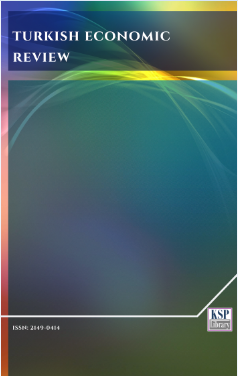Forecasting Daily Stock Volatility Using GARCH-CJ Type Models with Continuous and Jump Variation
Abstract
Abstract. In this paper we decompose the realized volatility of the GARCH-RV model into continuous sample path variation and discontinuous jump variation to provide a practical and robust framework for non- parametrically measuring the jump component in asset return volatility. By using 5-minute high-frequency data of MASI Index in Morocco for the period (January 15, 2010 - January 29, 2016), we estimate parameters of the constructed GARCH and EGARCH-type models (namely, GARCH, GARCH-RV, GARCH-CJ, EGARCH, EGARCH-RV, and EGARCH-CJ) and evaluate their predictive power to forecast future volatility. The results show that the realized volatility and the continuous sample path variation have certain predictive power for future volatility while the discontinuous jump variation contains relatively less information for forecasting volatility. More interestingly, the findings show that the GARCH-CJ-type models have stronger predictive power for future volatility than the other two types of models. These results have a major contribution in financial practices such as financial derivatives pricing, capital asset pricing, and risk measures.
Keywords. GARCH-CJ, Jumps variation, Realized volatility, MASI Index, Morocco.
JEL. C22, F37, F47, G17.
Keywords
References
Andersen, T. G., & Bollerslev, T. (1998). Answering the skeptics: Yes, standard volatility models do provide accurate forecasts. International Economic Review, 885-905. doi. 10.2307/2527343
Andersen, T. G., Bollerslev, T., & Diebold, F. X. (2007). Roughing it up: Including jump components inthe measurement, modeling, and forecasting of return volatility. The Review of Economics and Statistics, 89(4), 701–720. doi. 10.1162/rest.89.4.701
Andersen, T.G., Dobrev, D., & Schaumburg, E. (2012). Jump-robust volatility estimation using nearestneighbor truncation. Journal of Econometrics, 169(1), 75–93. doi. 10.1016/j.jeconom.2012.01.011
Barndorff-Nielsen, O. E. & Shephard, N. (2006). Econometrics of testing for jumps in financial economicsusing bipower variation. Journal of Financial Econometrics, 4(1), 1-30. doi. 10.1093/jjfinec/nbi022
Bollerslev, T. (1986). Generalized autoregressive conditional heteroskedasticity. Journal of Econometrics, 31(3), 307-327. doi. 10.1016/0304-4076(86)90063-1
Corsi, F. (2009). A simple approximate long-memory model of realized volatility. Journal of Financial Econometrics, 7(2), 174-196. doi. 10.1093/jjfinec/nbp001
Engle, R.F. (1982). Autoregressive conditional heteroscedasticity with estimates of the variance of United Kingdom inflation. Econometrica, 50(4), 987–1007. doi. 10.2307/1912773
Frijns, B., Lehnert, T., & Zwinkels, R.C. (2011). Modeling structural changes in the volatility process. Journal of Empirical Finance, 18(3), 522–532. doi. 10.1016/j.jempfin.2011.01.005
Fuertes, A.-M., Izzeldin, M., & Kalotychou, E. (2009). On forecasting daily stock volatility: The role ofintraday information and market conditions. International Journal of Forecasting, 25(2), 259–281. doi. 10.1016/j.ijforecast.2009.01.006
Huang, C., Gong, X., Chen, X., & Wen, F. (2013). Measuring and forecasting volatility in chinese stock marketusing HAR-CJ-M model. Abstract and Applied Analysis, 2013. 1-13. doi. 10.1155/2013/143194.
Koopman, S.J., Jungbacker, B., & Hol, E. (2005). Forecasting daily variability of the S&P 100 stock indexusing historical, realised and implied volatility measurements. Journal of Empirical Finance, 12(3), 445–475. doi. 10.1016/j.jempfin.2004.04.009
Martens, M. (2002). Measuring and forecasting S&P 500 index-futures volatility using high-frequency data. Journal of Futures Markets, 22(6), 497–518. doi. 10.1002/fut.10016
Nelson, D.B. (1991). Conditional heteroskedasticity in asset returns: A new approach. Econometrica, 59(2), 347–370. doi. 10.2307/2938260
DOI: http://dx.doi.org/10.1453/ter.v3i1.678
Refbacks
- There are currently no refbacks.
.......................................................................................................................................................................................................................................................................................................................................
Turkish Economic Review - Turk. Econ. Rev. - TER - www.kspjournals.org
ISSN: 2149-0414
Editor: [email protected] Secretarial: [email protected] Istanbul - Turkey.
Copyright © KSP Library




